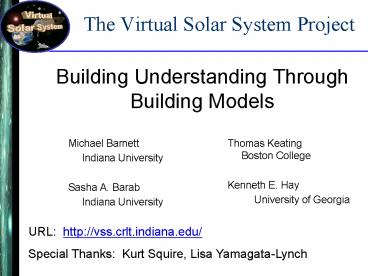The Virtual Solar System Project PowerPoint PPT Presentation
1 / 21
Title: The Virtual Solar System Project
1
The Virtual Solar System Project
Building Understanding Through Building Models
- Michael Barnett
- Indiana University
- Sasha A. Barab
- Indiana University
- Thomas KeatingBoston College
- Kenneth E. Hay
- University of Georgia
URL http//vss.crlt.indiana.edu/ Special
Thanks Kurt Squire, Lisa Yamagata-Lynch
2
Need for the Course
- Lecture format not effective (Tobin, 1988 Carr,
1997 Salomon 1993) - Alternative conceptions (e.g. Comins, 1993)
- Resistant to extinction
- Instructors often subscribe to same alternative
conceptions as students (Wandersee, et al., 1994) - Historical
- Become hybridized
- Concepts learned didactically are impoverished
(Whitehead, 1929 CGTV, 1993)
3
Need for the Course
- Inquiry into astronomical phenomena has been
difficult in traditional astronomy courses - Emergence of computational modeling
- The scientific process has been described as the
process of constructing models (Gilbert, 1991
Stewart et al., 1992). - Student constructing models engaging for
students (Penner, Lehrer, Schauble, 1998
Stratford, Krajcik, Soloway, 1998)
4
VSS Pedagogical Framework
- Non lecture-based course taught at IU and UGA for
the past three years - Participatory based (Barab Hay, in press)
- Technology as a tool for facilitates inquiry
- Work collaboratively
- Teacher as facilitator
- Designed to support students in participating in
domain-related practice - Construct models of the solar system
- Inquiry process
- Student practices evolve with and are reflexive
with their understanding - Activity is learning and learning is activity
5
Enabling Technology
- WYSIWYG VRML Editor
- On standard PCs
- Build 3-D models of astronomical phenomena
6
VSS Course Structure
- Course structure has evolved during the past two
years (Barab, Hay, Barnett, Keating, in press) - Project Based (Blumenfeld, et al., 1996)
- Students develop VR models around three projects
- Project 1 Celestial Sphere
- Project 2 Earth-Moon-Sun
- Project 3 Entire Solar System
- Each project has reflection activities
7
The Context for this Study
- Summer 1998
- Meet four times a week, 2hrs a day, for eight
weeks - Eight Students
- Three student teams
- Part of a larger study (e.g. Barab, Hay, Barnett,
Squire, in press)
8
Research Questions
- What is the relationship between model building
activities and conceptual understanding? - Do students show significant gains in
understanding astronomy concepts through
designing 3-D Virtual Reality astronomical
models?
9
Methodology
- Pre-Post Interviews
- Video taped every student work group
- Evaluated conceptual growth by a rubric
- Hierarchal in nature, scale 0 4
- 0 no conception
- 1 confused concepts and alternative concepts
present - 2 alternative conceptions presents (hybridized
concepts) - 3 partial understanding
- 4 sound understanding
10
Interview Questions
- Causes of the Moon Phases and Eclipses.
- What is the difference between a full Moon and a
lunar eclipse? - Changing Frame of Reference
- If you are on the Moon how long is a day?
- Seasons of the Earth
- What causes the Earths seasons?
- Relative Size
- Can you draw the solar system to scale?
11
Results Student Activity/Learning
- Learning of astronomical concepts evolved with
and from student practices and discussion
12
Results Student Activity/Learning
- Another example of the reflexive relation between
practice and conceptual understanding - Todd Okay, in a lunar eclipse does the Earth
block the light of the Sun? - Taro Yeah, lets see then Taro moves next to
him and says show me as he looks at the
computer - Todd So, in a lunar eclipse, wouldnt it make
sense to have the camera going from the Earth to
the Sun pointing to the screen If we put
the camera on the Sun and make it face towards
the Earth so we can see what the Earth is doing
when it gets in the way of the light of the Moon.
13
Results Conceptual Growth
Average student conceptual growth
14
Results Eclipses and Phases
- Seven out of eight, reached partial or sound
understanding - Combination of line of nodes, Moons orbital tilt
emerged as conceptual tools - Ericas constructed model
15
Results Seasons
- Pre-Interview Conceptions
- Classic alternative conceptions (six out of
eight) - Post-Interview
- All students knew importance of Earths tilt
- Only two knew angle of incidence of light on
Earths surface - Unable to model angle of incidence with VR
software
16
Results Changing Frame of Reference
- Changing frame of reference difficult for many
students - Pre-Interviews
- I have seen pictures titled Earth setting on the
Moon. I am sure it does happen. Yes it does. - Post-Interviews
- As the moon goes around the Sun, sunlight hits
the Earth. We definitely see phases of the Earth
because our model showed it. - Team Skywalkers Model
17
Discussion
- Strengths of constructing 3-D models changing
frames of reference - visualizing abstract concepts (line of nodes)
- supporting students conceptual growth
- Discussing their evolving understanding
18
Discussion Limitations
- Present VR environment
- Only gives a partial understanding of the seasons
due to inability to demonstrate angle of
incidence of light - Small class size
19
Implications
- 3-D modeling appears promising for supporting
students in understanding of astronomy (Parker
Heywood, 1998) - Need to understand environments that support
students in developing conceptual understanding
through practice - Designing models increasing student motivation
(Lehrer, 1993)
20
Current/Future Directions
- Findings feeding back into design of course
- In spring 2000 taught two courses of 35 students
- Completed VSS module for elementary school
students - Pre-post interviews
- VSS students and traditional class
- Pre-Post exam
- Same exam content as traditional course
21
Thank you
URL http//vss.crlt.indiana.edu/

